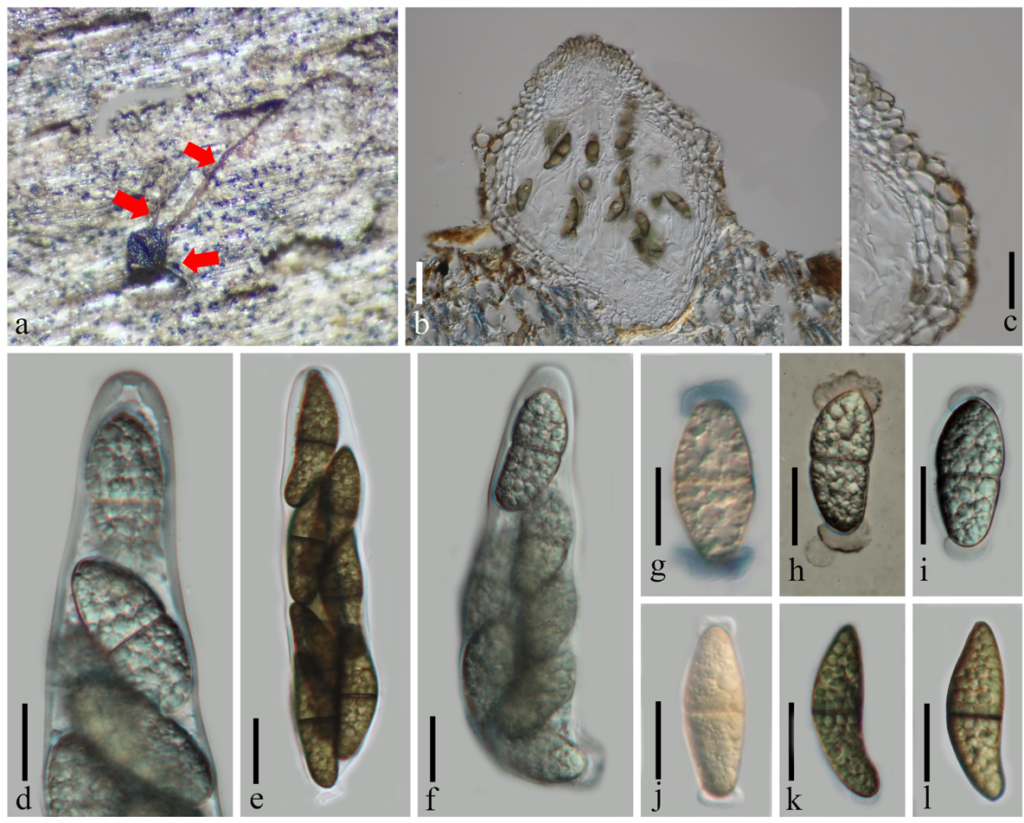Fungalpedia – Note 94 Ascagilis
Ascagilis K.D. Hyde
Citation when using this entry: Calabon et al., in prep – Fungalpedia, freshwater fungi. Mycosphere.
Index Fungorum, Facesoffungi, MycoBank, GenBank, Fig 1.
Ascagilis has sessile or stalked ascomata, cellular pseudoparaphyses, and 1-septate, brown ascospores mostly with a refractive mucilaginous pad at each end. Ascagilis was established by Hyde (1992) to accommodate A. bipolaris, which was isolated from submerged wood at the base of a waterfall in Australia. However, subsequent study led to the suppression of Ascagilis as its type species A. bipolaris was considered to belong in Jahnula (Hyde and Wong 1999). According to Dong et al. (2020), the presence of fusiform to ellipsoidal ascospores with bipolar pads is sufficient for distinguishing Ascagilis as a distinct genus based on their new collections, which is also supported by phylogenetic analysis. Ascagilis species can be distinguished by their ascomata appendage and ascospores, which exhibit characteristic features such as septa, mucilaginous pads, dimension and dimorphic/monomorphic form. However, insufficient sequence data for certain species (e.g., A. submersa, A. sunyatsenii and A. thailandensis) may obscure their delimitation in phylogenetic analyses (Dong et al. 2020). The genetic markers recommended for current classification include LSU, SSU and ITS. All species in Ascagilis have been exclusively discovered in freshwater habitats. Ascagilis species are observed and isolated from submerged decaying wood, making them important decomposers that play a crucial role in nutrient cycling within freshwater habitats (Hyde & Wong 1999, Hyde 1992, Inderbitzin et al. 2001, Hyde et al. 2017, Hyde et al. 2019, Dong et al. 2020).
Type species: Ascagilis bipolaris K.D. Hyde
Other accepted species:
Ascagilis bipolaris K.D. Hyde – freshwater species
Ascagilis guttulaspora (Qing Tian, Y.Z. Lu & K.D. Hyde) W. Dong, Doilom & K.D. Hyde – freshwater species
Jahnula guttulaspora Qing Tian, Y.Z. Lu & K.D. Hyde
Ascagilis queenslandica (Dayar., Fryar & K.D. Hyde) W. Dong, Doilom & K.D. Hyde – freshwater species
Jahnula queenslandica Dayar., Fryar & K.D. Hyde
Ascagilis seychellensis (K.D. Hyde & S.W. Wong) W. Dong, Doilom & K.D. Hyde – freshwater species
Jahnula seychellensis K.D. Hyde & S.W. Wong
Ascagilis submersa W. Dong, H. Zhang & K.D. Hyde – freshwater species
Ascagilis sunyatsenii (Inderb.) W. Dong, Doilom & K.D. Hyde – freshwater species
Aliquandostipite sunyatsenii Inderb.
Ascagilis thailandensis W. Dong, H. Zhang & K.D. Hyde – freshwater species
Figure 1 – Ascagilis species. a, d, f, h, i A. submersa. b, c, e, k, l A. thailandensis. g, j A. bipolaris. a Ascoma attached to the wood with broad hyphae (arrowed). b Section of an ascoma. c Structure of peridium. d-f Bitunicate asci. g-l Ascospores (h Ascospore in Indian Ink). Scale bars: b, c = 50 µm, d-l = 20 µm.
References
Dong W, Wang B, Hyde KD, McKenzie EHC et al. 2020 – Freshwater Dothideomycetes. Fungal Diversity 105, 319–575.
Hyde KD, Wong SW. 1999 – Tropical Australian freshwater fungi. XV. The ascomycete genus Jahnula, with five new species and one new combination. Nova Hedwigia 68, 489–510.
Hyde KD. 1992 – Tropical Australian freshwater fungi. I. Some ascomycetes. Australian Systematic Botany 5, 109–116.
Inderbitzin P, Landvik S, Abdel-Wahab MA, Berbee ML. 2001 – Aliquandostipitaceae, a new family for two new tropical ascomycetes with unusually wide hyphae and dimorphic ascomata. American Journal of Botany 88, 52–61.
Entry by
Yongxin Shu, Innovative Institute for Plant Health / Key Laboratory of Green Prevention and Control on Fruits and Vegetables in South China, Ministry of Agriculture and Rural Affairs, Zhongkai University of Agriculture and Engineering, Guangzhou 510225, Guangdong, P.R. China, Center of Excellence in Fungal Research, Mae Fah Luang University, Chiang Rai 57100, Thailand, School of Science, Mae Fah Luang University, Chiang Rai 57100, Thailand, Wei Dong, Innovative Institute for Plant Health / Key Laboratory of Green Prevention and Control on Fruits and Vegetables in South China, Ministry of Agriculture and Rural Affairs, Zhongkai University of Agriculture and Engineering, Guangzhou 510225, Guangdong, P.R. China, Mark S. Calabon, Division of Biological Sciences, College of Arts and Sciences, University of the Philippines Visayas, Miagao, Iloilo, Philippines
(Edited by Kevin D. Hyde)
Published online 19 September 2023
